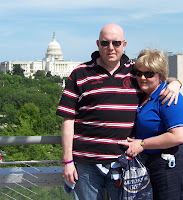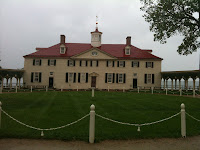That was the last bit of calm for a while, because life's getting interesting. It's not just the return to work which, now that I'm more than a month past my last chemotherapy treatment, will need to be approached without excuses, short days or drug-induced sluggishness. No, it's the very big business of buying and selling houses.
We finally got a buyer for the place I inherited from my mother. Scans of initial paperwork emailed back and forth between Baltimore and St. Louis during holiday, and now it's full steam ahead for a closing in about two weeks. A solid offer for that house in hand, we're now legally able to make our own offer for a home here. Which is exactly what we did at lunch today.
You may remember the start of my house hunt and my strict criteria for the village where I'll sink my roots ... someplace with a high TQ (thatch quotient). I haven't written since on the topic, but we have been busy managing a spreadsheet of ideal house features and setting up the initial mortgage. Most weekends before we left on holiday found us house hunting, and we'd developed a tidy little list of possibilities. Within those picturesque villages of my last blog entry on the topic, the price point that was our furthest stretch tended to throw up four bedroom places built in the late '70s or early '80s with some nice gardens. Pretty close to what I grew up in, really, but without the basement, half the garage and four times the price. Location, location, location.
And then we threw TQ, gardens and charm out the window for square footage, value for money and the convenience of the new.
The new marital home of the Basingstoke Bencards, on which we made an offer and were accepted earlier today, is so new it's still a brick shell standing amidst scaffolding on a muddy lot piled with construction material. It's in a high density, modern development that was a farm field just four years ago. No thatch, no duck pond, no ancient church or pub within a stone's throw. What possessed me to give up my fantasies of village life and pottering in a big garden?
Money, for one thing. The new house ... which is bigger than anything we saw before it ... is £150k below our target price. My perception was that modern English housing meant cramped rooms, shoddy quality and bad design. This three-story, detached, townhouse-style home has a great floor plan, lots of nice little design touches and a dream of a kitchen, clearly designed by someone who understood people who love to cook. The rooms are a good size and filled with light, an impression enhanced by doors between rooms on the ground floor that close to maintain heat but have large glass panels to give a sense of openness. The master bedroom is a two-room suite, the main guest room has its own en suite bathroom, Piers can have a sizeable "man cave" in the third bedroom on the top floor, and I get my own office in a studio with separate entry over the two-car garage.
The development, Sherfield Park, is remarkably attractive for new construction. The designers were clearly influenced by the streets of Bath. Though you'll never mistake it for a Jane Austen film set, the curving streets, classical porticos and architectural detailing create a pleasing neo-Georgian continuity. The developers have also taken a lot of care with landscaping, providing playing fields on the development's edge, a pond and wildflower meadow at its heart (which our new bedroom windows look over) and other green spaces. Best of all, beyond the confines of the development it's still farm and forest. Though the same distance from Basingstoke as the place we're renting, the surrounding area is far less developed. And given that the woods to the north are a Ministry of Defence training facility, it's not likely that it will be.
Nothing needs to be replaced or upgraded, and everything is state of the art. Great insulation. Efficient, double-glazed windows. Built-in kitchen appliances and alarm system. Computer network, communications and TV cabling laid into every room. No doubt influenced by the huge expense of renovation required to sell Mom's 40-year-old house, and the money I've had to dump into my 200-year-old cottage, charm has been trumped by efficiency in the face of reality.
And if you really want to talk reality: that price difference means a much smaller mortgage payment every month, which means we still may have some discretionary income for travel and nice restaurants. Which will continue providing stuff to write about. See ... I'm doing this for you, dear readers.
And if you really want to talk reality: that price difference means a much smaller mortgage payment every month, which means we still may have some discretionary income for travel and nice restaurants. Which will continue providing stuff to write about. See ... I'm doing this for you, dear readers.
All this gain does not come without pain, of course. The houses are cheek-by-jowl. The garden is small and overlooked by other people's windows. It's very much a housing development, not a village ... though there is a community centre and an area set aside for shops in the future. As a mixed development following modern government guidelines, there's housing at every price point. No well-heeled, comfortably prosperous and exclusive Hampshire village here; we'll be near the top end and we expect plenty of young families with children (not a positive on our list, children mean noise) and some social housing (aka welfare assisted). But there is a proper village, Sherfield-on-Loddon, a mile and a half up the road. Which means a pub and a small shop within walking distance. I've even spotted a church steeple, connected to what seems to be a manor house hidden behind high brick walls.
All in all, the balance is a happy one. All systems go for a move in late August.




























